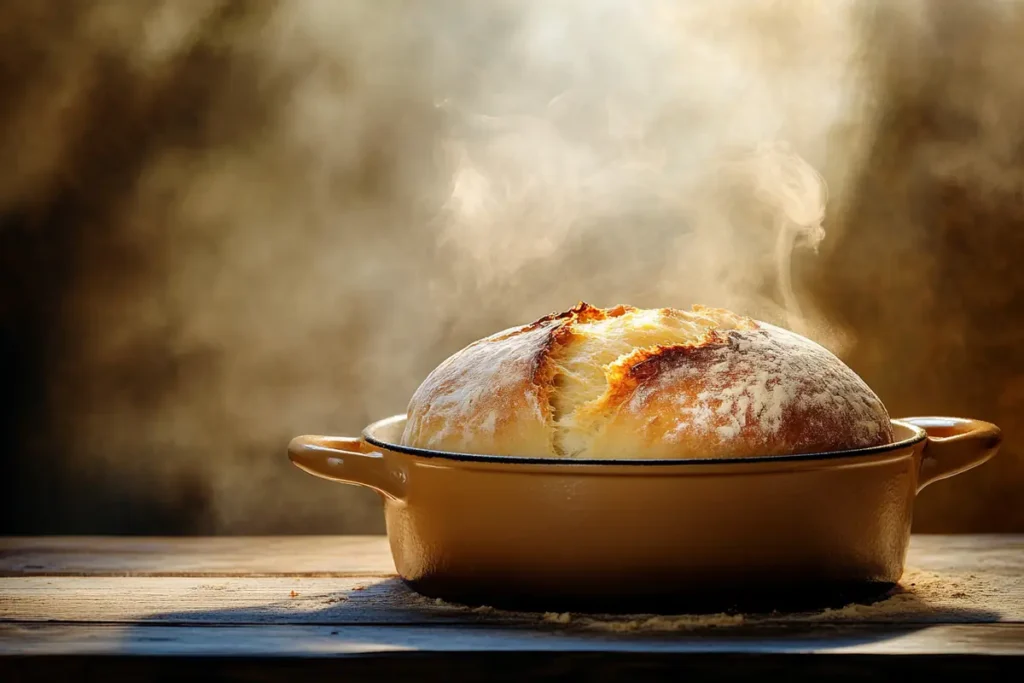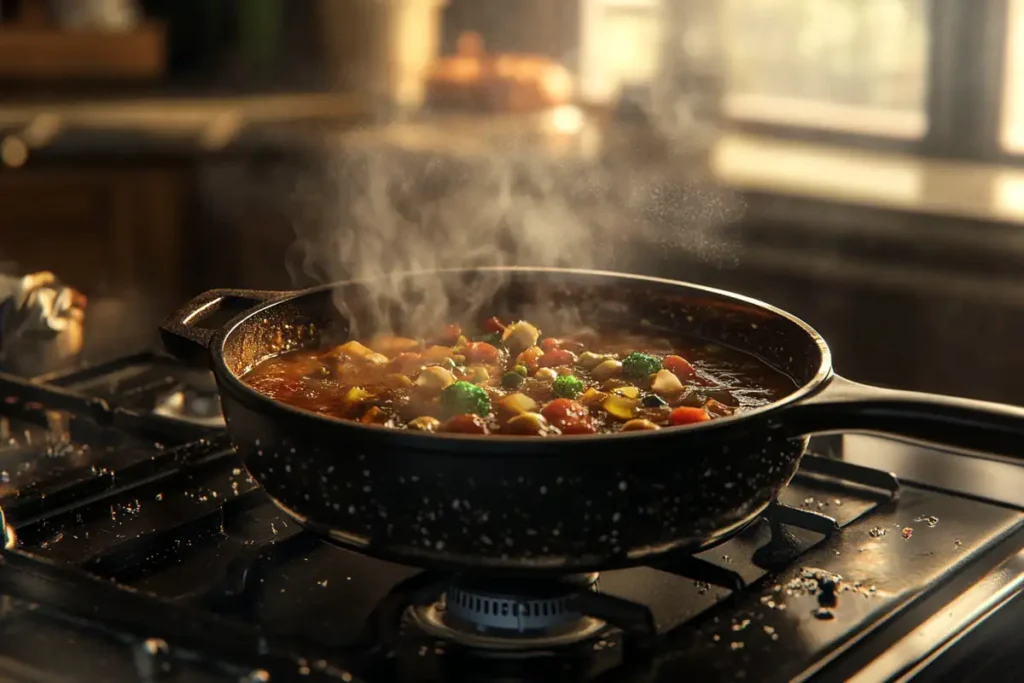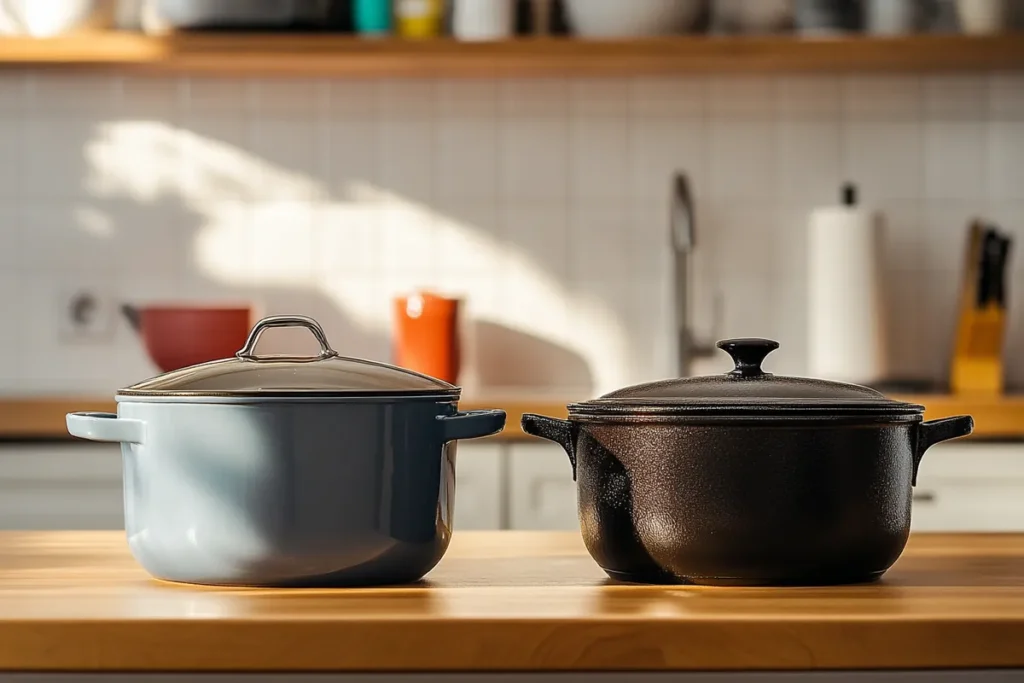Cocotte pans are one of those timeless pieces of cookware that have graced kitchens around the world, but they remain a bit of a mystery for many home cooks. If you’ve ever wondered what makes this pan so special, you’re not alone. A cocotte pan is more than just a pot; it’s a culinary powerhouse that excels in slow cooking, baking, roasting, and so much more.
From its French origins to its modern-day versatility, the cocotte pan has earned a reputation for transforming ordinary recipes into flavorful, tender, and perfectly cooked meals. Whether you’re simmering a hearty stew, braising a pot roast, or baking an artisan loaf, this pan can do it all. Its ability to retain and distribute heat evenly makes it an indispensable tool for creating dishes that look and taste amazing.
In this article, we’ll explore the many uses of a cocotte pan, its unique features, and why it deserves a permanent spot in your kitchen. We’ll take a deep dive into its history, the materials it’s made from, and the practical tips for using it effectively. Plus, we’ll compare it to other popular cookware like Dutch ovens and roasting pans to help you understand why it stands out.
Whether you’re a seasoned chef or a home cook looking to expand your culinary repertoire, the cocotte pan is sure to surprise you with its versatility and charm. By the end of this guide, you’ll not only know what a cocotte pan is used for but also why it’s a must-have in your kitchen. Let’s get started!
Introduction to Cocotte Pans
What is a Cocotte Pan?
At its core, a cocotte pan is a small, round or oval-shaped pot with a snug-fitting lid. Traditionally crafted from cast iron and often coated with enamel, this pan is designed for slow cooking and heat retention. It originated in France, where the term “cocotte” means “small pot.” The French culinary world has long used this versatile tool to perfect braised meats, stews, and baked dishes.
Definition and Origin of the Cocotte Pan
The cocotte pan was developed as a solution for cooking hearty dishes that required even heat distribution over long periods. French kitchens have relied on its exceptional ability to lock in flavors and moisture, which is why it’s often associated with rustic, flavorful cooking.
Brief History and Evolution
Originally, cocotte pans were made from raw cast iron, prized for their durability and natural heat retention. Over time, manufacturers began adding enamel coatings to make them easier to clean and more resistant to rust. The modern cocotte pan balances practicality with timeless design, appealing to home cooks and professionals alike.
Why It’s Called a Cocotte Pan
The name “cocotte” hails from the French word for “chicken,” referencing one of the pan’s primary uses: cooking poultry to tender perfection. However, its name has expanded to encompass its wider uses, including bread baking, roasting vegetables, and crafting rich stews.
What Materials Are Cocotte Pans Made From?
Cocotte pans come in various materials, each lending unique benefits to the cooking process. The two most popular materials are cast iron and enameled cast iron, which combine durability with versatility.
Cast Iron Cocotte Pans
Raw cast iron is the traditional material for cocotte pans. Its ability to retain and distribute heat evenly is unmatched, making it ideal for slow-cooked dishes. Cast iron pans develop a natural seasoning over time, enhancing flavor and preventing sticking.
Enameled-Coated Cocotte Pans
Enameled cocotte pans feature a smooth, porcelain coating that eliminates the need for seasoning. These pans are resistant to rust, easy to clean, and available in a variety of vibrant colors that add aesthetic value to your kitchen. While slightly heavier, they bring the same heat-retaining benefits as their raw cast iron counterparts.
Cocotte Pan Versatility
What is a Cocotte Pan Used For?
The cocotte pan is a culinary chameleon, offering an array of cooking possibilities. With its robust design and heat-retaining capabilities, it’s perfect for everything from slow cooking to baking. This versatility makes it a must-have tool for home cooks aiming to elevate their kitchen game.
Cooking Techniques Made Easy with a Cocotte Pan
A cocotte pan is like a jack-of-all-trades in the culinary world. Whether you’re braising, baking, or roasting, this pan excels in locking in flavors and creating rich, tender results:
- Braising: With its tight-fitting lid and heavy build, a cocotte pan is perfect for slowly cooking tough cuts of meat until they’re fall-off-the-bone tender.
- Baking: Yes, you can bake in it! The cocotte’s even heat distribution makes it ideal for bread and desserts, producing a golden crust and moist interior.
- Roasting: Use the cocotte for vegetables or small poultry, and enjoy perfectly roasted results every time.
Popular Recipes You Can Cook in a Cocotte

Let’s talk about the dishes that truly shine in a cocotte pan.
- Soups and Stews: The depth of the pan and its heat-retaining properties make it ideal for rich soups and hearty stews. Think lentil soup, beef bourguignon, or creamy chowders.
- Bread Baking: Artisan bread lovers rave about the cocotte’s ability to replicate bakery-quality loaves, with a crisp crust and soft, chewy center.
- Pot Roasts: A cocotte pan allows the meat to cook slowly, absorbing all the rich juices and seasoning, resulting in a flavorful, melt-in-your-mouth dish.
Advantages of Cooking in a Cocotte Pan
Why is this pan so widely loved? It’s because it marries practicality with outstanding cooking performance:
- Retains heat longer than most cookware.
- Ensures even cooking, eliminating hot spots.
- The lid locks in moisture, enhancing flavors.
- It’s multifunctional, suitable for both stovetops and ovens.
Using a Cocotte Pan Safely and Effectively
Can I Use a Cocotte on the Stove?

Absolutely, you can use a cocotte pan on the stove! Its durable construction allows it to handle high temperatures and distribute heat evenly. However, understanding the nuances of using this versatile pan on various types of stoves ensures safe and efficient cooking.
Using a Cocotte on Gas Stoves
On a gas stove, the cocotte pan performs beautifully. The flame directly heats the cast iron base, enabling even cooking across the entire surface. For best results, start with low heat to avoid thermal shock, especially for enameled cocottes. Gradually increasing the flame prevents any cracking or damage to the enamel coating.
Using a Cocotte on Induction Cooktops
Not all cookware works on induction, but most cocotte pans do because of their cast iron core. The magnetic base heats the pan efficiently. Always ensure the pan’s base is smooth to prevent scratching the glass surface. A heavy pan like this can sometimes be tricky to move, so handle with care.
Tips for Safe Stovetop Usage
- Always preheat gradually to preserve the enamel coating.
- Avoid using metal utensils to prevent scratching the surface.
- Use oven mitts or a thick cloth, as the handles get extremely hot.
What to Consider Before Using a Cocotte Pan
Proper preparation and care are key to maximizing the lifespan and performance of your cocotte pan. Whether you’re a beginner or an experienced cook, these tips will help you make the most of this versatile cookware.
Preheating and Heat Distribution
Cocotte pans thrive on slow, steady heating. Rapid temperature changes can lead to cracking or warping, especially in enameled versions. For stovetop use, allow the pan to heat evenly before adding ingredients.
Cleaning and Maintenance Tips
- Never use abrasive sponges or harsh detergents, as they can damage the enamel coating.
- Handwashing is recommended, even if the pan is labeled dishwasher-safe.
- To prevent rusting in raw cast iron pans, dry thoroughly and apply a thin layer of oil after each wash.
With these precautions, your cocotte pan can last for decades, providing reliable performance for countless recipes.
Comparing Cocotte Pans to Other Cookware
What’s the Difference Between a Cocotte and a Dutch Oven?

At first glance, the cocotte pan and Dutch oven look like siblings in the world of cookware. Both are robust, versatile, and designed for slow cooking and high-heat performance. However, key distinctions between the two can influence your choice, depending on your cooking needs and preferences.
Similarities in Design and Usage
Let’s start with what they have in common:
- Material: Both are typically made of cast iron or enamel-coated cast iron, providing excellent heat retention and even cooking.
- Versatility: Both can be used on the stovetop or in the oven, making them ideal for one-pot meals.
- Functionality: They’re designed for braising, baking, and roasting, with lids that help retain moisture and flavor during cooking.
Yet, despite these similarities, their differences lie in the details that can significantly impact your cooking experience.
Key Differences: Weight, Shape, and Lid Design
- Weight: Cocotte pans are generally lighter than Dutch ovens, making them easier to handle, especially when transferring from stovetop to oven. This feature is particularly useful for everyday cooks who prioritize convenience.
- Shape: Cocottes are often deeper with a more compact design, making them perfect for dishes that require depth, like bread or stews. Dutch ovens, on the other hand, tend to be wider and shallower, offering more surface area for tasks like browning meat or simmering sauces.
- Lid Design: Cocotte pans often come with a self-basting lid that features dimples or ridges on the underside. These promote moisture circulation, ensuring dishes stay juicy and flavorful. Dutch ovens typically have flatter lids, which may not offer the same level of moisture redistribution.
When to Choose a Cocotte Over a Dutch Oven
Choosing between the two largely depends on what you’re cooking. A cocotte pan is perfect for recipes that benefit from a more compact design and self-basting features, like tender roasts, casseroles, or bread. For larger meals or dishes requiring more surface area, such as searing multiple pieces of meat or cooking a large batch of soup, a Dutch oven may be the better option.
How Does a Cocotte Pan Compare to Other Specialty Cookware?
The cocotte pan isn’t just a competitor to the Dutch oven. It also holds its own against other types of cookware, proving its value across a wide range of cooking scenarios.
Cocotte vs. Saucepan
- Use Case: Saucepans are designed primarily for boiling, simmering, and reducing sauces. While they’re great for liquids, they lack the versatility of a cocotte pan, which excels at slow cooking and retains heat for longer periods.
- Cooking Capacity: A cocotte’s larger size and tighter lid make it ideal for hearty meals like stews or baked dishes, while a saucepan is better suited for smaller, quick-cook recipes.
- Durability: The thick cast iron construction of a cocotte pan allows it to withstand high temperatures and long cooking times, unlike saucepans, which are typically made of thinner metals.
Cocotte vs. Roasting Pan
- Use Case: Roasting pans are best for dry heat methods like roasting meats and vegetables, but they lack the moisture retention of a cocotte pan. If you need tender, slow-cooked results, the cocotte’s tight lid and self-basting design are superior.
- Versatility: Unlike a roasting pan, the cocotte pan transitions easily between stovetop and oven, making it ideal for recipes that require searing before roasting or slow cooking.
- Cleaning and Storage: Cocotte pans are easier to clean and often more compact for storage compared to large, open roasting pans.
The Unique Appeal of a Cocotte Pan
While other cookware pieces serve specific roles, the cocotte pan combines the best features of many, making it a multi-functional powerhouse. Its ability to braise, roast, bake, and simmer means you can streamline your kitchen tools without sacrificing performance. Whether you’re comparing it to a Dutch oven, saucepan, or roasting pan, the cocotte emerges as a clear winner for its versatility, durability, and ease of use.
By understanding these comparisons, you can confidently choose the cocotte pan as the right tool for your culinary needs. Its unmatched combination of style and functionality makes it an essential part of any kitchen.are collection.
FAQs About Cocotte Pans
What is the purpose of a cocotte?
A cocotte pan is designed for versatile cooking methods, such as braising, baking, roasting, and slow cooking. Its heat retention and even distribution make it perfect for hearty meals and tender results.
What to use a cocotte for?
You can use a cocotte pan for a variety of recipes, including stews, soups, pot roasts, casseroles, and even artisan bread. Its multifunctionality makes it a kitchen favorite.
Can I use a cocotte on the stove?
Yes, cocotte pans are safe for stovetop use. They work well on gas, electric, and induction stoves, thanks to their durable cast iron or enamel-coated construction.
What’s the difference between a cocotte and a Dutch oven?
While both are heavy-duty cookware, cocotte pans are often lighter and feature self-basting lids for moisture retention. Dutch ovens are generally larger and better for bulk cooking.
Are cocotte pans worth the investment?
Absolutely! A cocotte pan is a long-lasting, versatile piece of cookware that can handle everything from bread baking to slow cooking, making it a worthwhile addition to any kitchen.
Conclusion
Why a Cocotte Pan is a Must-Have in Your Kitchen
The cocotte pan isn’t just cookware; it’s a game-changer for anyone who values flavor, efficiency, and versatility in the kitchen. Its ability to seamlessly transition between stovetop and oven, coupled with its exceptional heat retention, makes it a prized possession for both novice and professional cooks.
Summary of Benefits and Versatility
From slow-cooked stews to golden-baked bread, the cocotte pan brings out the best in every dish. Its durable design ensures even heat distribution, while the tight-fitting lid locks in moisture, enhancing the flavor of your meals. Whether you’re roasting vegetables, crafting a hearty casserole, or baking a rustic loaf, this pan performs flawlessly every time.
Final Thoughts and Recommendations
If you’re looking to simplify your cooking routine while delivering restaurant-quality results, investing in a cocotte pan is a no-brainer. Not only does it elevate your dishes, but it also adds a touch of elegance to your kitchen with its timeless design. Choose one that suits your style and needs, and you’ll wonder how you ever cooked without it.
Print
One-Pot Chicken and Vegetable Cocotte Recipe
- Total Time: 55 minutes
- Yield: 4 servings 1x
Description
This comforting one-pot meal is perfect for showcasing the cocotte pan’s strengths. Tender chicken, vibrant vegetables, and aromatic herbs come together in a rich, flavorful broth. Perfect for weeknights or cozy family dinners.
Ingredients
- 4 bone-in, skin-on chicken thighs
- 2 tablespoons olive oil
- 1 medium onion, diced
- 3 garlic cloves, minced
- 2 medium carrots, peeled and sliced
- 2 celery stalks, chopped
- 1 cup baby potatoes, halved
- 1 cup chicken broth (low-sodium)
- 1/2 cup water
- 1 teaspoon dried thyme
- 1 teaspoon dried rosemary
- 1 bay leaf
- Salt and pepper to taste
- Fresh parsley for garnish
Instructions
- Prepare the Chicken:
- Season chicken thighs generously with salt and pepper.
- Heat olive oil in your cocotte pan over medium heat.
- Sear the chicken thighs skin-side down until golden brown, about 5 minutes. Flip and cook the other side for 3 minutes. Remove and set aside.
- Sauté the Aromatics:
- In the same pan, add diced onion and cook until translucent, about 3 minutes.
- Stir in minced garlic and cook for an additional minute until fragrant.
- Add Vegetables:
- Add carrots, celery, and potatoes to the pan. Stir to coat the vegetables in the aromatic mixture.
- Build the Broth:
- Pour in the chicken broth and water. Add thyme, rosemary, and the bay leaf. Stir well.
- Return the Chicken:
- Place the seared chicken thighs back into the pan, skin-side up.
- Cover the cocotte with its lid and reduce the heat to low. Let it simmer gently for 30 minutes or until the chicken is tender and fully cooked, and the vegetables are soft.
- Serve and Garnish:
- Remove the bay leaf. Taste and adjust seasoning with salt and pepper if needed.
- Garnish with fresh parsley and serve warm with crusty bread or over rice.
Notes
- You can customize the vegetables based on what you have available (e.g., zucchini, green beans, or parsnips).
- To thicken the broth, mash a few potatoes into the liquid before serving.
- For added flavor, a splash of fresh lemon juice can be stirred in at the end.
- Prep Time: 15 minutes
- Cook Time: 40 minutes
- Category: Main Course
- Method: Braising
- Cuisine: French-inspired
Nutrition
- Calories: 310
- Sugar: 3g
- Sodium: 240mg
- Fat: 16g
- Saturated Fat: 4g
- Unsaturated Fat: 12g
- Trans Fat: 0g
- Carbohydrates: 15g
- Fiber: 3g
- Protein: 28g
- Cholesterol: 80mg
Keywords: cocotte pan recipe, chicken and vegetables, one-pot meal

